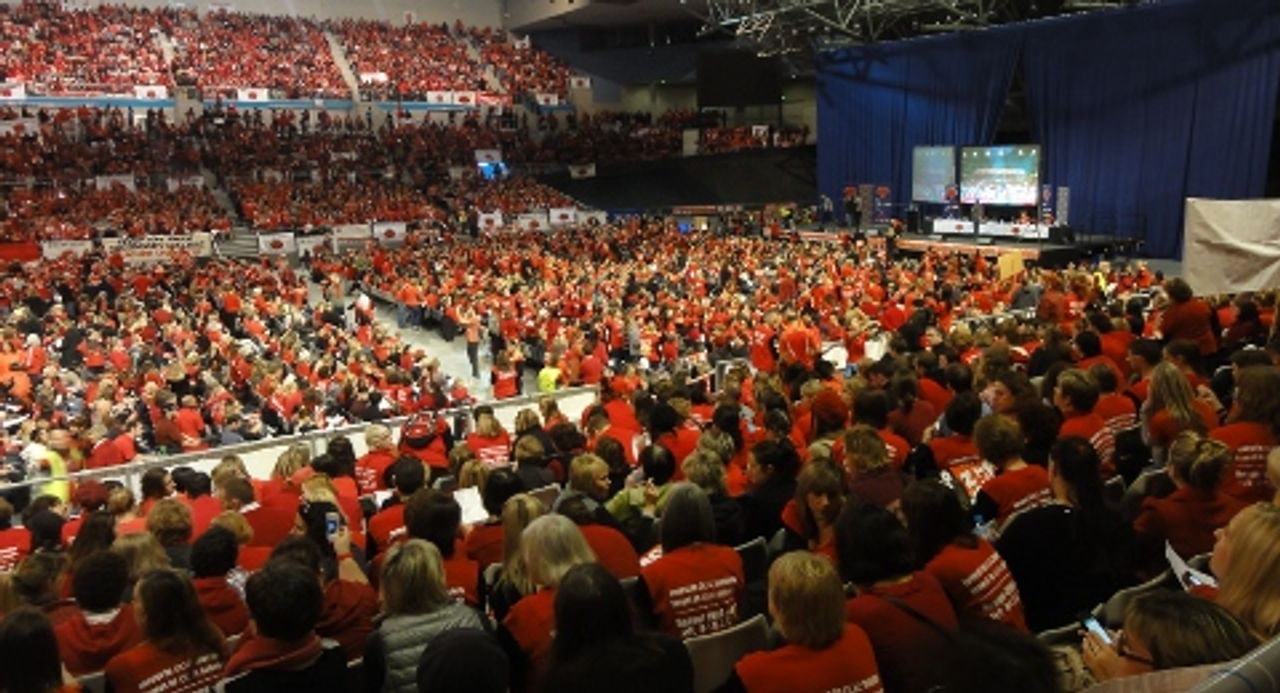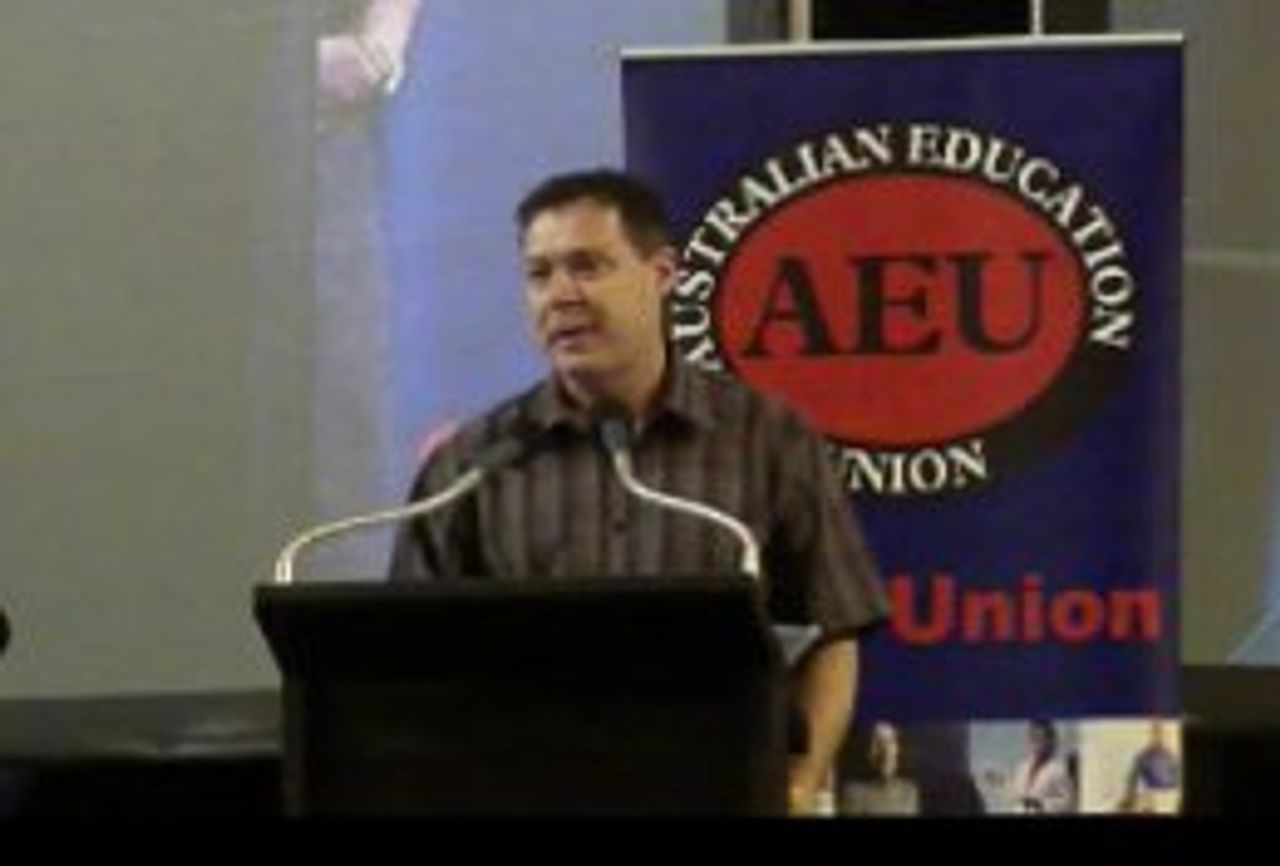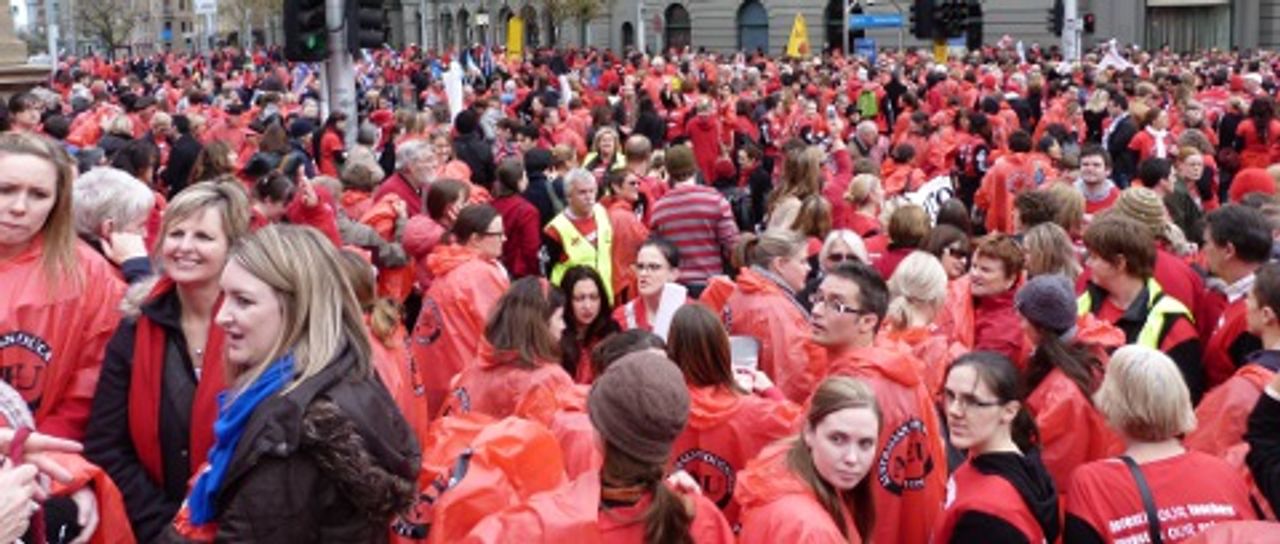An estimated 25,000 public school teachers in the state of Victoria went on strike yesterday, and about 200 primary and secondary schools were closed. Participation was significantly higher than during the last enterprise bargaining agreement in 2007-2008.
 The Victorian teachers’ mass meeting
The Victorian teachers’ mass meetingYesterday’s mass meeting convened by the Australian Education Union (AEU) filled a 10,000-capacity sports stadium in Melbourne, and about 1,000 more teachers watched proceedings on screens outside. Many in attendance were young teachers—the union reported that 2,000 teachers had recently joined in order to participate in the strike. Others travelled long distances from regional cities and towns.
The stoppage was over a new enterprise bargaining agreement (EBA) being negotiated between the AEU and the state government of Premier Ted Baillieu. The government wants to impose a 2.5 percent annual pay deal—a cut in real wages—make teachers work longer hours, introduce so-called merit pay, and tie annual salary increments to other “performance” benchmarks. These demands have a provocative character, and have fuelled the anger among teachers that was evident in yesterday’s industrial action.
Under successive Liberal and Labor state governments, and with the active collusion of the AEU, the public education system has been eviscerated. The union’s EBA log of claims includes several demands that it has no intention of fighting for—a 10 percent wage rise each year for three years, maximum class sizes of 20 students, caps on weekly teaching hours, and a reduction in the number of contract teachers. Premier Baillieu yesterday dismissed all this as “simply not affordable and not for consideration.”
Socialist Equality Party members and supporters played an important role in the mass meeting in opposing the AEU leadership and outlining an alternative socialist perspective for teachers to advance their interests and defend public education through a unified industrial and political struggle against the state Liberal and federal Labor governments.
At the beginning of the meeting, SEP member and long-standing teacher Will Marshall moved a procedural motion to allow the widest possible discussion on the EBA, instead of first allocating time for the union-organised “entertainment” (rap and music performances).
 Will Marshall
Will MarshallMarshall explained that at a mass meeting held in 2007, of the thousands in attendance, “a sum total of five teachers were able to voice their opinion,” before union leaders said that there was no time for further discussion. “Teachers with an alternative or oppositional view should have the opportunity to present their standpoint,” Marshall concluded. “The order of the meeting must be changed so that ordinary teachers get a voice.”
A significant minority, about 10 percent of the 10,000 teachers in attendance, supported the motion. Most voted with the union leadership, but there was a very large abstention. Later in the meeting SEP members moved an alternative resolution to the one proposed by the AEU leadership.
The AEU resolution was deliberately vague, committing the bureaucracy to nothing. It called for the union leadership to oversee “a range of bans and limitations to be implemented strategically throughout the campaign to escalate the dispute,” including “a further program of stop works of between one and 24 hours at a state-wide, regional and sub-branch level.” In their remarks, union leaders stressed that they would ensure that any industrial action did not breach the Labor government’s draconian Fair Work Australia industrial laws.
The AEU resolution also proposed to launch a “political campaign targeting ministers’ electorates and the electorates of marginal Coalition MPs.” The bureaucracy is clearly determined to channel teachers behind the Labor Party and its state election campaign in 2014, covering up Labor’s record at the federal and state level of driving the pro-business offensive against public education.
In accordance with union meeting rules, the alternative resolution advanced by SEP members was presented by AEU state president Mary Bluett. She began by sarcastically complaining about its length, but as she read the text there was significant applause from teachers, especially in response to the resolution’s call for a boycott of the Labor government’s NAPLAN standardised testing regime and for a united struggle of all teachers, education support staff, TAFE and university employees. (For the full resolution, see the end of the article “School teachers to strike in Victoria”.)
Will Marshall spoke against the AEU’s resolution, focussing on the need for the development of a political struggle against the federal Labor government. “Baillieu is carrying out the Gillard government’s agenda to maintain budget surpluses at the expense of ordinary people,” he said. “The cuts to education and the public service—overseeing all of this is the Gillard government—but this is not even mentioned in the resolution. Federal Labor and Baillieu have the same agenda: pay for performance, contract teaching, increased productivity, competition between schools, increased funding for the private sector over government schools—an education designed to suit the interests of business.”
Ollie Gordon also supported the SEP resolution and opposed the official motion. He outlined the disastrous impact that the government’s latest funding cut will have on students at Dandenong High, the school where he teaches in an outer working class area. “This will devastate programs and staffing in the school and further disadvantage students and their families,” he explained. Gordon also stressed that the Gillard government was behind the attack on education, concluding his remarks by stating: “It must be a political campaign against the Liberal state government, the Labor federal government and their Green coalition partners.”
The “Teachers Alliance” group, led by members of the pseudo-left organisations Socialist Alternative and Socialist Alliance, intervened to support the AEU bureaucracy and its resolution. They moved an amendment, which they said was aimed at “strengthening the leadership’s campaign”, calling for another one-day strike and mass meeting later in the year. The AEU leadership, however, rejected this out of hand.
In the end, the meeting overwhelmingly approved the AEU resolution. The SEP’s alternative motion was not put to the vote.
Teachers then marched through the city centre, gathering outside the state parliament. State Labor leader Daniel Andrews stood on the parliament steps, applauding as the teachers arrived, again underscoring the AEU’s attempt to channel the teachers’ industrial campaign behind the Labor Party’s electoral preparations. Outside the parliament, Victorian Trades Hall secretary Brian Boyd and Australian Nursing Federation leader Lisa Fitzpatrick addressed the teachers, mouthing empty pledges of solidarity. Earlier this year, Fitzpatrick played a critical role in shutting down and selling out a determined campaign waged by public hospital nurses.
 Teachers outside parliament
Teachers outside parliament
Shortly after the end of the rally, Labor’s federal workplace relations minister, Bill Shorten, told the media that he has been “watching this matter.” Shorten declared that he “may at some point have to become involved if the Baillieu government and the teachers are unable to resolve their differences,” adding, “I don’t particularly want to take sides, because I may have to get involved in helping fix it if the Baillieu government can’t.”
Shorten’s remarks should serve as a warning to teachers. Any intervention by the Gillard government “to fix” the dispute will be to ensure that its education agenda—also that of the Baillieu government—is imposed. As it did in 2007-08, the AEU will play the key role in blocking any opposition by teachers.
Receive news and information on the fight against layoffs and budget cuts, and for the right to free, high-quality public education for all.
